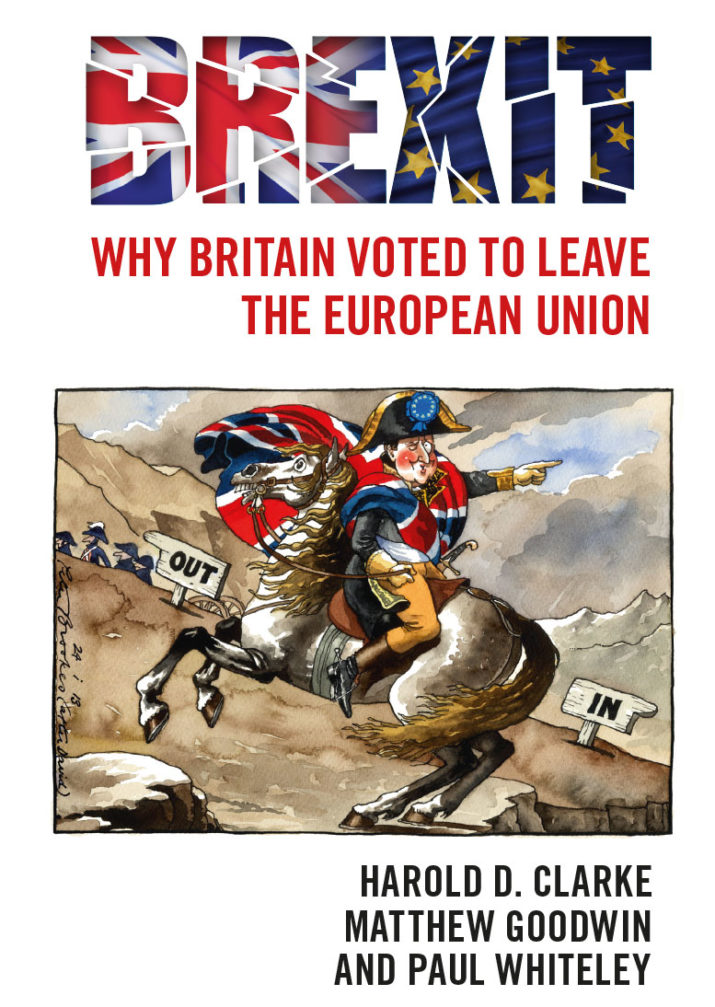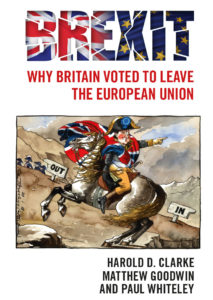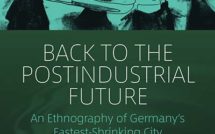
Brexit: Why Britain Voted to Leave the European Union by Harold D. Clarke, Matthew Goodwin and Paul Whiteley

There are many stories seeking to explain the outcome of the 2016 referendum on UK membership of the EU. These include stories that focus on the long-term status of the UK as an “awkward partner” since it joined what was then widely known in the UK as the “Common Market” in 1973; stories which focus on the divisive impact of “Europe” on party politics and particularly on the Conservatives, which was so relevant in the period leading up to Cameron’s decision to hold a referendum; stories which consider the increasingly divergent political economies of the UK and, in particular, an EU “core” of Eurozone states pushing ahead with deeper economic integration; stories which focus on the referendum campaign itself – its intrigue, personalities and tactics; and stories which look at voting and public opinion data to answer the question: who voted what and why. All of these stories offer us something in terms of trying to make sense of both the decision to hold a referendum on EU membership and the seismic outcome in 2016, which saw the British public narrowly vote to leave the EU.
Brexit was one of the first book-length contributions to this rapidly growing set of stories. Broadly, it is in the camp of those interested in the survey-data-driven “who-voted-what-and-why” question. But unlike many analyses in that camp, it considers the results of the referendum within the broader context of a rigorous and detailed analysis of public opinion during the decade preceding the referendum and of the rise of the UK Independence Party (UKIP), a growing political force, particularly during the latter part of that period.
For those seeking to recall the events leading up to the referendum and the campaign itself, it offers a concise overview in its early chapters (1-3). It highlights Cameron’s failure, as far as the majority of the British public was concerned, to secure a substantive ‘renegotiation’ of the UK’s terms of membership with the EU. It outlines the key strategic messages of the Leave and Remain campaigns, with the former focused on “taking back control,” particularly of immigration, and the latter on the economic and security risks of leaving. And it describes the personalities that lined up behind these two groups and the (in the event perhaps useful) division in the Leave campaign between the mainstream “Vote Leave” and the UKIP/Nigel Farage-led “Leave.eu”. It does so with reference to the insights of some of the key protagonists on both sides.
The book’s most valuable contribution, however, lies in its detailed data analysis of the political attitudes and behavior of the British electorate in the twelve years prior to the vote, which allows for an interesting contextualization of the referendum itself. In particular, the book draws on the monthly Essex Continuing Monitoring Survey (2004-16) (chapter 4) and a 2014 survey of UKIP members (chapters 5 and 6). A central finding of the data analysis in chapter 4 is that attitudes to the EU over this period were driven by perceptions of whether the EU was adequately delivering on (or, in some instances, hindering delivery of) so-called “valence issues” – issues on which there was widespread public agreement. These issues were, in particular, economic prosperity, immigration control (restriction) and sovereignty/ democracy. Public faith in the domestic leaders and parties supposed to be delivering on these issues also had an impact on public opinion on the EU. In short, many people formed opinions on the EU based on their assessments of a combination of the economy, immigration, sovereignty and the abilities of domestic leaders/parties to deliver on those issues. Subjective judgments on personal economic circumstances and on immigration were shown to be particularly significant. Negative views on these issues led to increased euroskepticism, one manifestation of which was increased support for UKIP.
The data on UKIP members, analyzed in chapters 5 and 6, also throws up some interesting findings. Notably, the authors show that these members’ views – inter alia, their hostility to immigration, low trust in the political system, and a sense of being “left behind” – were shared by a sizeable percentage of the UK population beyond the party. This helps to explain the rapidly improving electoral fortunes of UKIP, culminating in their successes in the 2014 European Parliament elections and 2015 general election. It also helps us understand the context for the decision to hold a referendum in 2016 and, indeed, the result.
Come the referendum itself (analyzed in chapter 7) many of these valence issues were “baked in” for many people – for a sizeable group on both sides this meant that the referendum campaign itself was unlikely to swing their vote – but substantial fluctuations in opinions on the EU over the preceding decade and the relatively even split in opinion (reported in chapter 4) suggested that there was nevertheless a lot to play for in the campaign itself. The authors’ analysis suggests, among other things, that strong ‘left behind’ feelings were associated with fewer concerns with respect to the risks of leaving (people in such a negative situation perhaps felt they had nothing to lose) and risk perceptions were also significantly impacted either way by support for leaders on either side of the campaign. In particular, the book highlights the significance of the “Boris effect” – the decision of Boris Johnson, very popular with many of the electorate, to put his weight behind the Leave campaign.
The central strength of these core chapters (4-7) lies in the detailed and rigorous data analysis, which highlights the complex ways in which ‘calculations, emotions and cues’ interacted to drive the UK public’s perceptions of the EU in the decade leading up to the referendum and in the context of the referendum campaign and vote itself.
While the authors are expert at describing, and increasing our understanding of, the nuances of public attitudes and perception, in places they too-readily accept the validity of those subjective views. This is the case in relation to immigration and the democratic deficit. On the former, the authors’ suggestion that there has been downward pressure on wages at the lower end of the pay scale is (at the very least) highly debatable with respect to EU migration. Moreover, it is not acknowledged that for many of those most opposed to migration, their views had not been formed with reference to any direct experience of migrants or of the effects of migration (and, indeed, many with direct experience voted Remain). On the democratic deficit, the book does not do justice to the broader debates on the phenomenon. Nor does it consider the ways in which the UK has been a shaper (as well as taker) of EU policy (for instance, the single market project) and the ways in which it has managed to evade certain supposed threats to its sovereignty/democracy, through, for instance, its non-participation in Schengen and the single currency. Many in the electorate of course, also missed these important realities. And I would postulate that their misperceptions and misunderstandings of the EU were created by a combination of Leave campaigners and important sections of the media (including, in the short-term referendum context, through well targeted social media campaigns). But the role of the media (and associated money and interests) is not substantively addressed in the book. This is perhaps because many of these public perceptions on the EU are not regarded by the authors as mis-perceptions at all.
This impression is reinforced when reading the concluding chapters, on the consequences of Brexit and on euroskepticism elsewhere in the EU. In chapter 8 the authors are, contrary to most expert opinion, pretty sanguine about the prospect of Brexit: it is claimed that the economic consequences are unlikely to be as severe as many experts claimed and that migration will be more easily controlled outside of the free movement regime. On the economy, the claim is built on the assertion that the UK’s membership of the EC/EU has not led to economic growth. Many economists would disagree. More importantly, the assertion is not of central relevance to an assessment of the economic consequences of leaving the EU single market, which has shaped the UK economy in important ways for decades. Moreover, the brief mentions of trade focus on “tariff free access”, failing to explicitly consider the significance of the single market in eradicating non-tariff barriers through regulatory alignment and recognition (of particular importance for, inter alia, the car industry and the sizeable UK services sector). On immigration, the notion that the UK will be able to take back some degree of control of migration post-Brexit is also to potentially understate the ways in which the UK political economy has evolved to depend on such migration: there will certainly be significant economic costs to bear when asserting any such “control”.
In chapter 9 the book surveys euroskepticism in other EU member states. While, as the authors note, we do see the rise of radical parties and anti-EU parties, the uniqueness of the British case is in my view understated. Although we have seen the rise of a “soft’ – we need to change the EU – euroskepticism everywhere in recent years, the “hard” – let’s leave – euroskepticism that we see in the UK is far less prevalent. Notably, we saw a bump in EU support in other member states following the UK referendum; to the extent that the Front National in France flirted with a “hard” euroskepticism in 2017, it was punished for this at the polls; and some far-right parties, such as the Austrian Freedom Party, are now avowedly pro-European. Moreover, the absence of an awkward “Britain” in the EU might permit further integration in some areas among the 27 (there is already some sign of this on defense/security).
Finally, the authors are reasonably optimistic about the chances of what has become known as a “cake-and-eat-it” Brexit: a Brexit that would permit continued single market access/membership and the end of the free movement regime. Such optimism is based on the potential economic losses likely to be incurred by EU member states in the case of a “hard” Brexit. Certainly at the time of writing this review (though I would have also said the same following the vote) such optimism looks misplaced: the EU-27 has held together and prioritized the integrity of the single market and indivisibility of the so-called “four freedoms” (of movement of goods, services, capital and people).
It must be acknowledged that even a year or so after the authors penned these chapters it is still no easy task to accurately predict the future for Brexit Britain or for the EU-27 and they may yet be proven right in their assertions. However, as noted, there are plausible counter-arguments to those put forth in the book and a proliferation of (in my view more plausible) predictions of the future, that are grounded in an understanding of the nature of the EU’s single market and the europeanization of British politics, polity, policy and political economy.
That all said, this is not primarily a book about the future of Britain or of the EU and these problematic chapters are not central to its core argument or purpose. This is a book about explaining what happened in 2016 and why. On that front, it is a resounding success and an excellent contribution. Its core arguments are insightful and extremely compelling. They are grounded in detailed survey evidence and highly-skilled and detailed data analysis. If you want a nuanced picture of why people voted as they did in 2016, Brexit will be an extremely valuable resource.
Reviewed by Owen Parker, The University of Sheffield
Brexit: Why Britain Voted to Leave the European Union
By Harold D. Clarke, Matthew Goodwin and Paul Whiteley
Publisher: Cambridge University Press
Hardcover / 272 pages / 2017
ISBN: PB 9781316605042
To read more book reviews, please click here.
Published on July, 2 2018.




